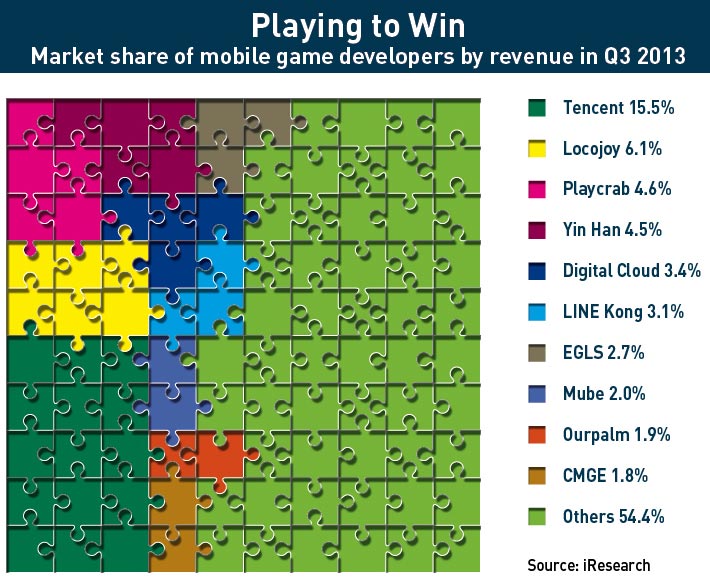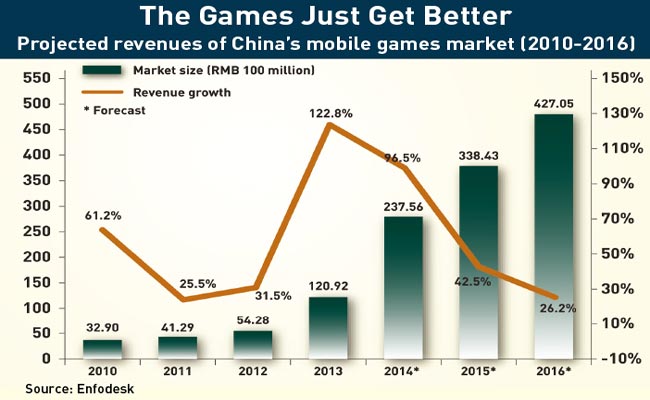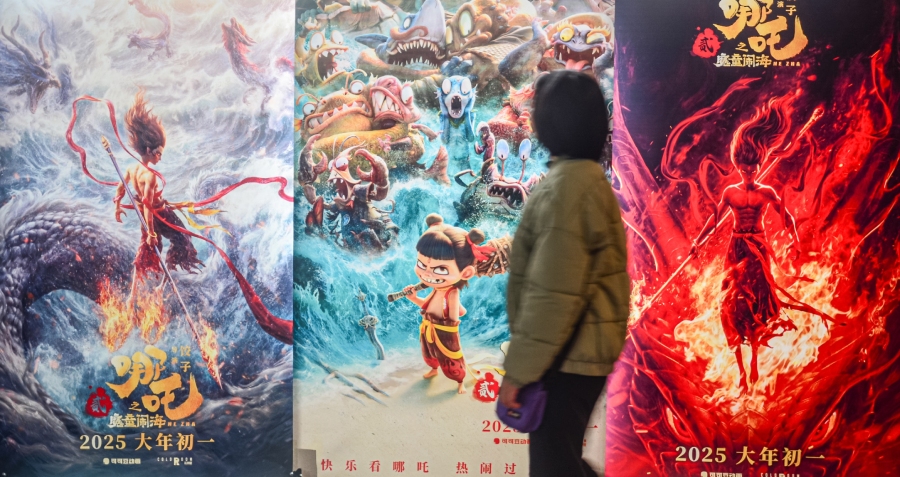
Gaming in China is a passion that knows no bounds. But can the Chinese gaming industry build something as phenomenal as Angry Birds?
Max Zhang has 16 games on her smartphone and usually plays 2-3 hours per night. The 26-year-old Shanghainese teaching assistant prefers casual games for their simplicity. “I don’t want to use my head after a long work day,” she says, adding that she regularly changes the games on her phone because they become passé quickly.
Zhang also plays exclusively on her mobile. “I’ve never played on a desktop computer,” she says.
Millions of Chinese like Max are gaming exclusively on their phones as smartphone penetration rates soar and connectivity improves in the world’s largest internet market. Lucrative opportunities abound for game developers, operators and distribution platforms, but so do risks.
The numbers augur promise for investors. In 2013, China became the fastest growing mobile gaming market in the world, expanding at a 156% clip to reach $2.2 billion as it added 75.9 million new gamers, according to a report released in March at the China Mobile Gaming Conference in Beijing.
That explosive growth has heralded a flurry of mergers and acquisitions in China’s mobile gaming sector, with market leader Tencent—China’s largest internet company—spending billions of dollars as it shores up its position.
Tencent’s shopping spree is just one indication that competition for China’s fickle consumers is intensifying, with a game’s lifecycle lasting just six months to a year. With more than 200 Android app stores, China’s mobile gaming market is highly fragmented, complicating distribution, while rampant IP piracy remains a concern for Western game companies. Those able to overcome distribution and piracy travails still need a viable free-to-play business model to monetize, which by definition is difficult at best. Chinese consumers strongly favor games that are free to play and offer in-app purchases integral to the gaming experience.
While China already has 215 million mobile gamers, they comprise just over one-third of its 618 million netizens, leaving enough market share to inspire bold moves and vicious competition to make the next viral game.

Smartphones of the People
2013 saw smartphone shipments rise 86.3% year-on-year and 3G subscribers increase 78.8%, according to Nomura Research. Nomura predicts China’s mobile games market will grow at an annual rate of 59% from 2014 to 2018, surpassing the PC client-based market, which is expected to reach $23.4 billion in 2018 according to a 2014 Niko Partners report.
Inexpensive Android phones are opening up access to a new gaming audience in lower-tier cities, says Ibrahim Dai, TalkingData’s head of global business development. “The phones are cheap but device functionality is high, which means all the latest games work as well on a 1,000-yuan Xiaomi as [on] a Samsung Galaxy [which costs upwards of RMB 4,000],” he says. These mid-to-low end smartphones have brought mobile gaming to millions of users who otherwise would not have had it due to socioeconomic barriers, Dai adds.
Second and third-tier Chinese cities offer the greatest potential for mobile gaming, says Frank Yu, a veteran of China’s gaming industry and CEO of the Gamify Your Life consultancy in Beijing. “They [residents of those cities] are in the middle of nowhere and bored,” he says. “But they are always on their smartphones and games are the number 1 thing people download onto their mobile devices.” A smart tip for developers, both domestic and foreign.
Beijing’s Invisible Hand
Beijing has been ambivalent about foreign influence in its gaming market since the beginning. It banned console sales in 2000, claiming that playing video games could harm the mental health of Chinese youth. After gaming moved exclusively online in the wake of that ban, the Ministry of Culture set up a committee in 2004 to screen foreign online video games for objectionable content. In October 2013, Beijing lifted the console ban in Shanghai’s Waigaoqiao Free Trade Zone, permitting foreign game companies to manufacture and sell games in China provided they establish a domestic operation in the zone. But that amnesty is expected to have little effect given the market’s migration to mobile.
Competition in the early days of Chinese online gaming was so heated that developers adopted a free-to-play model, in which they earned revenue from value-added services like the sale of virtual items instead of selling the games themselves, says Dai of TalkingData. With a low barrier to entry, freemium monetized well, says Yu. “Players end up paying more for all those little in-app purchases than buying a game outright, but they have no choice if they want to keep playing.” An early freemium successes in China was US-based Blizzard Entertainment’s World of Warcraft, a multi-player online role-playing game.
Beijing again intervened in the gaming market after Google pulled out of China in 2010 by stunting the domestic functionality of the Google Play app store. It is nearly impossible to install the Google Play store or any Google Services on China-based mobile phones, because their operating systems have been programmed to prevent it, says Chris Mills, President of Hitcents, a technology consultancy.
With Google sidelined, hundreds of local app stores stepped in to fill the void, presenting a major challenge for foreign game developers accustomed to Google Play and Amazon in the Android app market, says Maxim De Wit, who directs the international division of the Global Mobile Game Confederation (GMGC) in Beijing. “Distribution is essential to the success of a good game. You need to make sure app stores are pushing your game, pushing downloads.”
China Mobile Game 101
Chinese player preferences, which differ considerably from their Western counterparts, are a good place to start. “Chinese players’ interest curve is not gradual,” says Eric Tan, the China Country Manager of the French game developer Gameloft. “In the first 10 seconds, you need to draw them in.” In the case of its most successful game in China, Despicable Me, Gameloft made it easier than in the West, providing a tutorial for how to defeat the Level 1 adversary or “boss”, he adds.
Hardcore Chinese gamers, whose in-app purchases drive revenue for game developers in China, prefer action role-playing games (RPG) with fantasy elements and a Chinese cultural theme. RPGs monetize well because the games are designed to make in-app purchases urgent, for instance a player cannot advance to the next level of a game without buying a certain weapon. The RPGs I Am MT Online, Clash of Clans, Da Zhang Men and Dragonbane were among China’s best-selling mobile games in 2013, according to AppAnnie.
In-app purchases allow Chinese gamers to show off their virtual high-end equipment, said Xiao Jian, the CEO of China Mobile Game Corporation, in an April speech to employees published in a press release. Xiao couched such purchases in the context of Chinese aspirations for status, just like driving a luxury car, or wearing a high end watch.
Advertising is less important as a source of revenue than virtual items. “It’s a very small piece of our revenue pie,” Tan says, adding that players are loath to multi-task when they are absorbed in a game, especially since mobile screens are smaller than computer monitors. Max Zhang, the Shanghainese gamer, says she ignores the “annoying” ads that appear while she is playing.

Meanwhile, working with a Chinese game publisher, which selects local distribution channels for foreign partners, can make distribution smoother, says Yu. “A publisher can give you more market share, but they may have their own agenda, to make their channels happy at the expense of the game developer.” That may involve distributing games in app stores where publishers have close relationships rather than those that are best for attracting a game’s target user, he adds.
Rovio, maker of the Angry Birds mobile game, ran into trouble with its publisher when they cloned the game without permission and began selling it in Chinese app stores—a common problem foreign developers encounter. Eventually, Rovio enlisted the mediating services of the GMGC to persuade its publisher to remove unlicensed versions of the game from app stores.
It is also in the interest of app stores to have original versions of a game. Pirates don’t have access to the source code, so a pirated version is usually missing parts of the game that need to be purchased, says De Wit.
Even so, for Rovio, piracy was not all bad. CEO Peter Vesterbacka has spoken publicly on a number of occasions of how piracy helped Angry Birds branding by making it a household name among Chinese consumers.
Lackluster innovation from Chinese game developers gives foreign developers an edge, says Yu of Gamify Your Life. “Many Chinese games are a copy of a copy of a copy,” he says. “Chinese gamers know shanzhai [a Chinese colloquial term that means ‘fake’] when they see it.”
Yet, despite the advantages foreign game developers have in the China gaming market, none of them have been as successful as Shenzhen-based Tencent, China’s largest publicly-traded internet company with a market capitalization of $139 billion and ranked fourth globally in the sector after Google, Amazon, and Facebook.
Distribution Control
Tencent has emerged as the dominant player in the mobile gaming market on the back of a powerful ecosystem that includes a large online-games business and the popular QQ and WeChat messaging apps that act as distribution channels for its games. So far, it has released 12 mobile games through those channels, six of which have more than 10 million users.
In the mobile gaming market, “market power belongs to companies that control the distribution channels—and Tencent controls them,” says Zhang Kaifu, an assistant professor of marketing at the Cheung Kong Graduate School of Business. “Distribution is more important than quality.” Zhang further explains that Tencent has used its might to rig distribution such that many smartphone makers pre-install their games on their phones.
To monetize its user base, Tencent targets China’s huge “casual gamer” segment rather than high-spending, “hardcore” RPG gamers, Zhang says. That strategy is working. Together, QQ and WeChat generated gaming sales of RMB 600 million in the three quarters leading up to December 31, 2013. The fifth top-grossing game in 2013 in China app stores—and the only non RPG—was a casual action game made by Tencent called TianTian Ku Pao, which means Cool Running Every Day. Overall, total online and mobile games revenue increased 34% last year from 2012, reaching a record RMB 31.97 billion.
At the same time, Tencent’s acquisitions include a 2012, purchase of a majority stake in US online games developer Riot Games—maker of League of Legends, one of the most played games in the world—for nearly $400 million. It followed this with an investment in US game and technology developer Epic Games, taking a 40% stake for $330 million. More recently, in March, Tencent spent $500 million for a 28% stake in CJ Games Corp, the biggest game publisher in Korea by downloads and revenue, according to AppAnnie.
Shopping Spree
M&A activity surged in China’s mobile gaming industry in 2013, with investors lured by gaming’s proven monetization capacity and high net margins, typically 20-40% according to the Asian Venture Capital Journal. From January to October 2013, nearly 57% of the 22 acquisitions valued at RMB 16.89 billion made by China A share companies were related to mobile gaming, according to iResearch, a Beijing-based technology consultancy.
The M&A surge has accelerated in 2014. Xiaomi Ventures invested $20 million in Westhouse, a mobile gaming business, in February, taking a 4.7% stake. In April, Shenzhen-based ZQGame said in a statement it plans to acquire assets of three internet content and online game providers for RMB 1.75 billion ($281.69 million).
Meanwhile, Alibaba is reportedly planning to launch its own mobile gaming product to keep up with arch rival Tencent as it did last year in the social media sector by taking a stake in SinaWeibo.
With competition so fierce at home, more Chinese firms are expanding into foreign mobile gaming markets. Online games developed by Chinese firms generated revenue of $1.82 billion overseas in 2013, up 219.3% from 2012, according to a recent report issued by the Publishers Association of China, with most of the growth attributed to mobile games.
Waves of the Future
Asia is the largest market for Chinese games. In Taiwan, at least five out of the 10 most popular mobile games are from mainland China. Chinese RPGs are also popular in South Korea and dominate the mobile gaming market in Vietnam. “Chinese cultural storylines can be more easily exported to East and Southeast Asia,” says Yu of Gamify Your Life, adding that in Southeast Asia’s emerging markets, the freemium model works as well as in China. But Chinese developers still need to heed some important differences in gamer habits, such as a preference for games with a slower click rate, said China Mobile Games and Entertainment CEO Xiao Jian in a speech to employees last month.
The US and European markets pose a greater challenge. They are attractive to Chinese developers because they boast a high payment ratio and loyal gamers. Yet the quality of most Chinese games is not up to market standards in the West, says Yu.
“They are very good at telling Western developers to localize, but they struggle to localize [in Western markets] themselves,” says Tan of Gameloft.
In China, even as gaming companies remain an investor favorite, it may be too early to say they are consolidating. “It was like this a few years ago in the US, but when Zynga [a social gaming company whose stock lost 75% of its value in 2012 after a 2011 IPO] crashed, that killed investor enthusiasm in the sector,” De Wit says.
The one aspect of China’s mobile gaming market that seems certain is Tencent’s control of it. None of the Shenzhen-based internet giant’s rivals combines its depth in online gaming, superior distribution channels, huge user base and vast capital. In Tan’s view, Tencent will harness those resources to promote its own games and those for which it negotiates exclusive distribution rights in China, gaining ever greater market share. For that reason, Tencent is partnering with the UK’s King Digital Entertainment to release a Chinese version of the hit game Candy Crush Saga in China this year. Candy Crush was 2013’s most downloaded free mobile game app.
“Tencent may end up with a market monopoly,” Tan says. For that very reason, all developers, foreign and domestic, best root for Tencent’s success. Tencent is driving mobile game popularity in China more forcefully than any other competitor, so for now, the market continues to grow in some part because Tencent commands it.



















